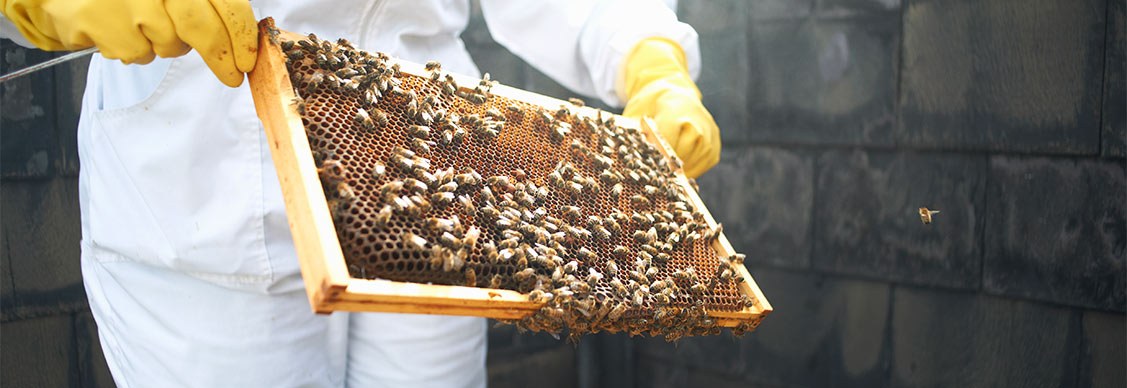Why the rooftops are alive with the buzz of bees
Beehives on the roofs of commercial and residential buildings are quietly becoming more common
City rooftops may not be the most obvious place to home colonies of bees.
But amid growing efforts to bring nature back into urban areas, there’s a buzzing new world emerging high above the apartments, office desks and hotel rooms of today’s high-rise buildings.
A London housing development that Brent Council approved late last year will include bee bricks - nesting sites for solitary bees - along with green roofs, while JLL’s Manchester office has recently added two hives, each hosting 70,000 bees.
Such developments are feeding the fast-growing trend for urban beekeeping. In New York, where urban beekeeping was made legal in 2010, some 2.4 million Italian honeybees changed hands in April 2021 as buyers collected their apiary boxes.
Rapid urbanisation has accentuated the need to increase biodiversity to help improve air and water quality and keep cities cooler as temperatures rise, says Jeremy Kelly, Global Research Director at JLL.
He points to the likes of Melbourne’s Urban Forest Strategy and efforts by Paris to put green roofs at the centre of its green transformation, along with London’s Wild West End partnership, backed by Grosvenor Britain & Ireland and The Portland Estate among others, to encourage birds and insects back into the capital’s green corridor
“Cities are increasingly measuring their biodiversity and coming up with new ways to integrate it into urban planning,” Kelly says. “Introducing bees and creating new rooftop habitats improve the overall resilience of cities to climate change.”
Part of city life
Insects pollinate more than 80 percent of crop species in Europe, including most fruits, many vegetables, and some biofuel crops; honeybees are among the most important pollinators.
A study by the University of Reading estimates that globally, bees’ pollination service has an economic value of approximately £120 billion (US$169 billion) and an annual value to the UK alone of around £690 million.
But in recent years, they’ve needed human help to get their work done. Oslo was the world’s first city to help save bees in 2015 with its bee highway, while in Germany, eight colonies of bees were introduced to the roof of a LaSalle Investment Management shopping centre in Darmstadt in 2019.
Over in the UK, five hives housing some 300,000 bees sit in the Crown Estate’s Princesshay rooftop garden in Exeter as part of a wider initiative which includes a garden of herbs and fruit trees. The bees’ honey is then sold in the shopping centre below.
Other landlords are taking a slightly different approach. Aberdeen Standard Investment sponsored an offsite beehive for each of its build-to-rent developments. When harvest time came around, residents received a jar of honey from the hive they sponsored.
Looking for more insights? Never miss an update.
The latest news, insights and opportunities from global commercial real estate markets straight to your inbox.
Rethinking roofs
More real estate owners are now thinking about how they can put their urban rooftops to good use as part of their wider sustainability plans.
“Beehives and bee-friendly building methods are only one part of the wider biodiversity effort,” says Erin Williams, a consultant in JLL's Upstream Sustainability Services team. “A green rooftop means bees can happily pollinate, while delivering benefits for a building’s immediate community, from local food sourcing to improved air quality.”
The increased focus on making office buildings more pleasant places to be for employees has brought a range of biodiversity strategies to the fore, she adds. Rooftop gardens featuring a range of plants, living walls and walking trails through outside space are becoming more popular.
What’s more, there are now financial benefits to greening buildings. Green roofs can provide total energy savings of up to 6.7 percent for the space directly below, as well as reducing noise levels by 11 decibels and boosting property values by as much as 6.9 percent, according to the Nature Based Solutions to The Climate Emergency Report by the UK Green Building Council.
And for residential developers facing more environmental regulation in the coming years, incorporating biodiversity early is a smart choice, Williams explains.
“Homebuilders will soon be asked to offset their biodiversity impact on all developments – and incorporating biodiversity early could save on costly offsetting outlays, which is expected to be higher than the alternative of simply putting more green space into their initial building plans,” she says. “For clients, particularly developers, it is proving that biodiversity pays.”
For investors, Kelly says that the focus is largely on net zero carbon but they’re starting to talk more about biodiversity as more buildings that incorporate green space in innovative ways emerge, from Milan’s Bosco Verticale to the Mille Arbres mega project in Paris.
“There’s now a definite shift towards the quality of that greenness now,” he says. And on World Bee Day (20 May), that’s welcome news for bees.
